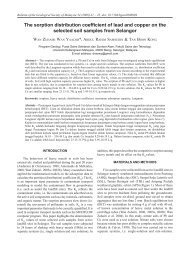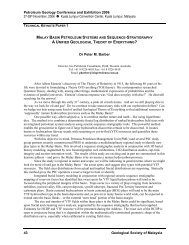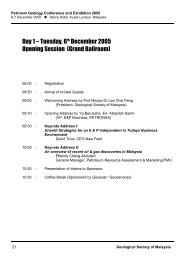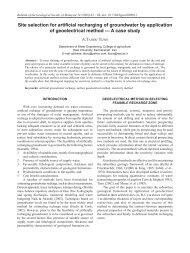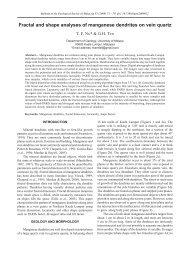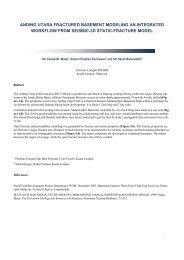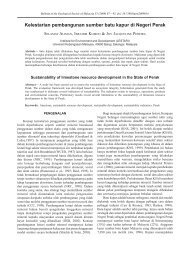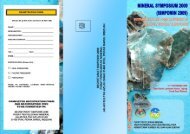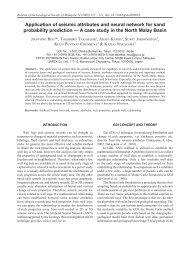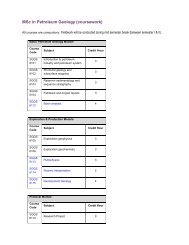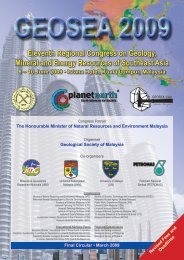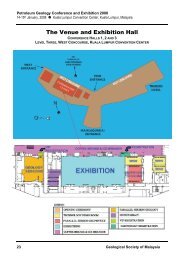National Geoscience Conference 2011 - Department Of Geology ...
National Geoscience Conference 2011 - Department Of Geology ...
National Geoscience Conference 2011 - Department Of Geology ...
Create successful ePaper yourself
Turn your PDF publications into a flip-book with our unique Google optimized e-Paper software.
NATIONAL GEOSCIENCE CONFERENCE <strong>2011</strong><br />
11 – 12 June <strong>2011</strong> • The Puteri Pacific Johor Bahru, Johor, Malaysia<br />
Paper P1-3<br />
Numerical computation of depth of buried geologic structure from the gravity<br />
anomaly data<br />
Syed Mustafizur Rahman 1* , Noushin Naraghi Araghi 1 , Rosli Saad 1 , M. N. Mohd Nawabi 1 &<br />
Khairul Arifin Bin Mohd Noh 2<br />
1<br />
School of Physics, Universiti Sains Malaysia, 11800 USM, Pulau Pinang, Malaysia<br />
*Email Address: smrahman@usm.my<br />
2<br />
<strong>Geoscience</strong> and Petroleum Engineering <strong>Department</strong>, Universiti Teknologi PETRONAS,<br />
Bandar Seri Iskandar, 31750 Tronoh, Perak, Malaysia.<br />
Keywords: geology, structure, gravity, depth, computation<br />
Introduction<br />
The gravity anomaly interpretation is mostly done by iterative methods. Iterations start to compute gravity<br />
anomaly for a model with few known geologic parameters. Computed gravity anomaly is compared with the<br />
observed values and sometimes the model needs to be modified in order to obtain reasonable agreement. Several<br />
methods have been developed to identify the shape (Sharma & Geldart, 1968; Abdelrahman & El-Araby, 1993;<br />
Salem et al., 2003) and depth (Abdelrahman, 1990; Elawadi et al., 2001) of geological structure assuming simple<br />
source geometry from gravity data, though the simple geometries are not geologically realistic in most of the cases.<br />
In many contributions, numerical methods have been presented the estimation of depths of the geological structures<br />
of the gravity anomalies. This research is also introduced a numerical approach to estimate depths of simple models<br />
from residual gravity anomaly.<br />
Methodology<br />
The gravity effect of simple gravity models such as a sphere, an infinite horizontal cylinder, and a semi-finite<br />
vertical cylinder at an observation point (x,z = 0) centered at x = 0 and buried at a depth z can be generalized as:<br />
b m<br />
DCz R<br />
g(<br />
x)<br />
=<br />
(1)<br />
2 2<br />
( x + z ) a<br />
where, D = πGρ and G is the universal gravitational constant, ρ is the density and R is the radius of the shapes. The<br />
values of other variables are expressed below as shown in Table 1.<br />
Using the gravity value g 0<br />
at x = 0, Eq. (1) can be normalized and written as:<br />
2<br />
g(<br />
x)<br />
⎛ z ⎞<br />
g<br />
n<br />
( x)<br />
= = ⎜ ⎟<br />
g<br />
2 2<br />
x z<br />
0 ⎝ + ⎠<br />
where, g 0<br />
= DCz b-2a R m . Eq. (2) can be further written as:<br />
a<br />
(2)<br />
1<br />
1<br />
n n<br />
=<br />
2<br />
2 2<br />
( g ( x)<br />
) a x + ( g ( x)<br />
) a z z<br />
(3)<br />
Eq. (3) has solved for z in this work as:<br />
z<br />
N<br />
N<br />
2<br />
4 ⎛ 2 ⎞<br />
∑ xi<br />
− ⎜∑<br />
xi<br />
⎟<br />
i= 1 ⎝ = 1<br />
=<br />
⎠<br />
N<br />
N N<br />
2<br />
1/ a 2<br />
∑ xi<br />
(1/ g<br />
n<br />
( xi<br />
)} − ∑ xi<br />
∑<br />
i=<br />
1<br />
= 1 i=<br />
1<br />
(1/ g ( x )}<br />
where, N is a number of observations and using Eq. (4), z can be obtained numerically.<br />
n<br />
i<br />
1/ a<br />
Depth computation<br />
Synthetic data<br />
The proposed method has been investigated using synthetic gravity data. The cylinder and sphere models of<br />
having a density contrast of 2.5 x 10 3 kg/m 3 , radius of 5 m and buried at different depths. Though not shown here,<br />
the gravity anomalies were computed along a 100 m profile at an interval of 1 m. A different degree of noises have<br />
also been added over the synthetic gravity data, however the computed depths were also found less erroneous.<br />
Field data<br />
Figure 1 shows the residual gravity anomaly profile of the gravity map of the Humbolt salt dome, TX, USA. This<br />
data has been interpolated with an interval of 0.15 m using splines method. Applying spherical model (C=4/3, b=1,<br />
a=3/2 and t=3) the estimated depths are shown in Table 2.<br />
(4)<br />
73



